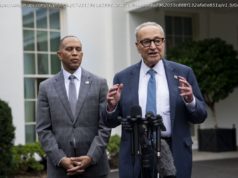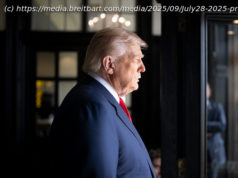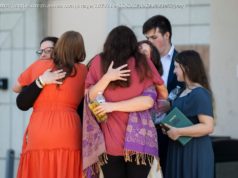The parade was more low key than a parade staged in April 2017 that featured an array of ballistic missiles, exacerbating tensions with the United States
TOKYO — North Korea celebrated its 70th anniversary Sunday with a parade featuring tens of thousands of goose-stepping soldiers, along with columns of tanks and heavy artillery, but notably did not show off the intercontinental ballistic missiles that are believed to be capable of reaching the United States, according to reporters at the scene.
The parade was more low key than a parade staged in April 2017 that featured an array of ballistic missiles, exacerbating tensions with the United States.
Much of the parade was dedicated to civilian efforts to boost the economy, the Associated Press reported, underscoring a major policy shift announced by the country’s leader, Kim Jong Un, earlier this year to focus on economic development. Another major theme was the reunification of the Korean Peninsula, carved into two by the Soviet Union and the United States after World War II.
The absence of nuclear-capable missile systems was seen as a conciliatory gesture during a period of intense diplomatic outreach and negotiation.
“That choice alone suggests Kim’s intention to underline the seriousness of his ‘New Strategic Line,’ announced earlier this year that privileges the country’s economic betterment after the ‘completion’ of the country’s nuclear deterrent last year,” said Ankit Panda, a strategic expert and adjunct senior fellow in the Defense Posture Project at the Federation of American Scientists.
“It also suggests that as long as negotiations are on, North Korea’s nuclear-capable systems will maintain a low profile.”
President Donald Trump applauded the lack of intercontinental ballistic missiles on his Twitter account Sunday.
“This is a big and very positive statement from North Korea. Thank you To Chairman Kim,” Trump wrote. “There is nothing like good dialogue from two people that like each other!”
The parade to mark the 70th anniversary of the founding of the Democratic People’s Republic of Korea began with ranks of soldiers, followed by tanks, trucks carrying rocket launchers and heavy artillery. Some tanks carried traditional slogans calling on the army to “Destroy the U. S. Imperialist Aggressor, the sworn enemy of the DPRK.”
But that imagery was balanced with flowers and colored balloons, floats on the economy and unification, and spectators waving flags of a unified Korea, Reuters reported.
“All Koreans should join forces to accomplish unification in our generation,” the official Rodong Sinmun newspaper wrote in an editorial. “Unification is the only way Koreans can survive.”
The parade came at a sensitive time as the United States and South Korea try to engage the North in a process they hope will eventually lead to it giving up its nuclear arsenal. But while South Korea’s President Moon Jae-in is due in Pyongyang for a summit with his North Korean counterpart from Sept. 18 to 20, talks with the United States have hit a roadblock over who should make the next move.
Washington wants Pyongyang to move decisively toward dismantling its nuclear weapons program, but North Korea insists it first wants a declaration that the 1950-53 Korean War is over, as a way of helping guarantee its security and build trust.
Grace Liu, a research associate at the James Martin Center for Nonproliferation Studies in Monterey, California, said the low-key parade appeared to be aimed at maintaining a “relatively civil dialogue” with Seoul and Washington, especially given Moon’s impending visit next week.
“Overall, a scaled-down ‘non-escalatory’ parade assumes that they’re sticking with the plan to maintain talks with the United States and Republic of Korea,” she said. “Although trying to take the spotlight off of their nuclear program might mean that they’re confident that their nuclear capabilities are fulfilling their purpose of getting R. O. K./U. S. at the table.”
The Korean War ended in an armistice but not a peace treaty. An end-of-war declaration would only be a first step toward an eventual peace treaty, but many in Washington fear such a declaration could be used to undermine the legitimacy of the U. S. troop presence in South Korea.
Kim himself did not speak at the event, leaving it to Kim Yong Nam, the head of the country’s parliament, to make an address emphasizing the economic goals of the regime, not its military might, Reuters reported.
There had been speculation that Chinese president Xi Jinping might make his first trip to Pyongyang for the parade, but in the end he sent Li Zhanzhu, the head of the National People’s Congress and the third in rank in the Communist Party hierarchy.
Li stood at Kim’s right during the parade, underlining the marked improvement in relations between the neighbors this year, with Kim traveling to China three times to meet Xi. Kim was seen laughing and holding hands with Li as he oversaw the celebrations.
China’s president also sent a message expressing “the unshakable policy of the Chinese party and government to successfully defend, cement and develop the bilateral relations” between the two nations, according to Korean Central News Agency.
Russia also sent its third highest-ranking official, Valentina Matviyenko, the chairwoman of its Federation Council, or upper house of parliament. She had an audience with Kim on Friday, at which he was also pictured laughing.
Later on Sunday, the celebrations will continue with the opening of what are known as North Korea’s Mass Games, a synchronized display of gymnastics and dance performed by tens of thousands of people working in unison. The games are being staged for the first time since 2013 and are officially called “Glorious Country” this year.
Start
United States
USA — Political North Korea celebrates 70th birthday with parade — but doesn't show off...





